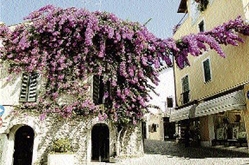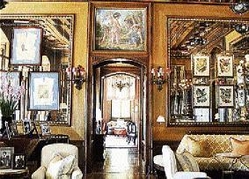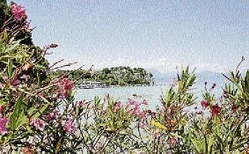Lake Garda's fabulous villas and historic villages
Published: Wednesday | September 2, 2009

Laura Tanna - LETTER FROM LAURA
Guarded by a 13th-century castle surrounded by a moat, Sirmione village occupies a narrow peninsula jutting into the southern tip of Lake Garda. Garda is the largest of Italy's renowned lakes, east of Lakes Maggiore and Como, with the snow-covered Dolomite Mountains far distant beyond the glittering blue water.
We fly from London to Verona, rent a car for the 45-minute drive northwest to Sirmione and are met with quizzical stares as we slowly manoeuvre our car through the pedestrians who fill Sirmione's narrow mediaeval lanes. Accessible only by boat or drawbridge, vehicular traffic is allowed just to those staying at hotels within the old village, which is where our Villa Cortine Palace Hotel is indeed located.
Built a century ago, the neoclassical villa sits amid beautiful gardens, enhanced by statues. Neptune, god of the seas, welcomes visitors at the end of a grand entrance, beyond a majestic gate. Opposite Villa Cortine stands the villa once owned by the husband of Maria Callas, the opera star who frequented Sirmione in the '50s. The scent of cypress trees permeates an open-air terrace where we dine in that lingering half-light of growing dusk that lasts far into summer evenings in Europe.
Church bells ring out each hour, each half hour, and in the morning, little brown birds wait expectantly for crumbs to drop, chirping all the while as they fly off with their prizes. Blue, pink and lavender hydrangeas are in full bloom this end of July, while bright-red geraniums, deep-rose oleander trained into trees and groves of lemons vie with purple bougainvillaea to give the cobble-stoned streets a festive air.
Tourists
All manner of little shops lure the visitor in, but one kind wins over all others: ice cream shops displaying vast mounds of the delicious treat in different colourful flavours. By mid-morning, the tranquil village becomes inundated with tourists who arrive by steamers from other lake villages, and within a few minutes, every other person wanders about with an ice cream cone in hand.
The Rocca Scaligeri is the main attraction. Building began in 1277 by the powerful Scaligeri family of Verona who fought off other feudal families from Lombardy to bring a measure of stability to the area. Both the 13th and 14th centuries were turbulent times in northern Italy and this castle is considered a prime architectural example of a strong and well-developed fortress. The other attraction, at the very tip of the peninsula, is the Grotte di Catullo, where the Roman poet, Catullus, had a home in the 1st century BC.
Former United States ambassador to Jamaica, Brenda LaGrange Johnson, heard we would be staying in the Lake Garda area and recommended that we visit another fascinating villa midway up the western side of the lake, Villa Feltrinelli, in Gargnano.
The villa's history is as intriguing as its interior rooms are resplendent. So secluded that we literally drive past the entrance to its narrow gate, opening on to a lane that wends its way through a wooded area to the lakeside villa, this was originally the home of the Feltrinelli family who made their wealth through commerce in lumber, then in building railroads, founding a private bank and so on, from father to two sons to nephew.
Designed by the Milanese architect Alberico Barbiano di Belgioioso in the art nouveau style in 1892, the villa's own fact sheet describes an unusual bit of World War II history. In October 1943, the Nazi government of Germany, in particular Rommel and Wolff, decided that their ally, Italian dictator Benito Mussolini, should establish his headquarters in Villa Feltrinelli, where he remained under German guard until April 1945. He spent his last 600 days as a "forced guest" at the villa before dying at the hands of partisans as he fled north towards Switzerland.
After the war, family member Giangiacomo Feltrinelli became a member of the Communist Party and used the villa as a hiding place while he became increasingly involved in terrorist activities, to the extent that he caused his own demise when, according to the hotel's notes, "Giangiacomo died in the explosion of the bomb he was placing under an electricity pylon in Segrate, near Milan, on March 1st, 1972." History becomes so much more interesting when one learns about it through people and their esoteric activities!
Increasingly uninhabited, the villa was sold by Giangiacomo's son and in 1997, Bob Burns, founder of Regent International Hotels, bought the villa and restored it splendidly, highlighting the ceilings' exquisite wood carvings, and hand-painted fresco artwork, original antique furniture, historic photographs in silver frames and stunning chandeliers.
Activities
The grounds and activities include a croquet lawn, swimming pool and private boat for touring Lake Garda. Now a very exclusive hotel with only 40 rooms, and the requirement of a minimum two-day stay, I wrote ahead to Villa Feltrinelli to request a luncheon reservation which was granted and while the cuisine was not what we expected - lukewarm pasta and excessive dressing on the Caesar's salad - the natural beauty of the setting, luxurious interiors and incredible sense of history made for a most memorable day.
A less successful outing was a drive up the eastern side of Lake Garda to Malcesine to take the cable car up Monte Baldo for a refreshing view of the Dolomite peaks and the Gruppo di Brenta mountain range. Between Garda and Bardolino (yes, home to that famous wine), the traffic, bumper to bumper, inched past crass commercialisation of the worst kind, with Gardaland - someone's answer to Disney World - being the most vulgar in terms of despoiling the landscape with signs for miles on end. Instead of an hour and a half, the trip took two and a half, with only the last half hour of beauty.
Once there, we were greeted with a long queue at the cable cars and a sign announcing: "Because of intense traffic, there will be a one-hour wait to ascend Mt Baldo!" Wait we did, with scores of German-speaking families, most with screaming babies. While the view was pleasant enough, and a lone cow with its neck bell ringing whenever it moved brought back memories of Alpine summers, we would have been better advised to take a boat trip on the lake!

Medieval village of Sirmione.

Interior of historic Grand Hotel a Villa Feltrinelli with resplendent carved wooden ceilings, antique furniture and artwork.

View of Lake Garda - photos by Laura Tanna








